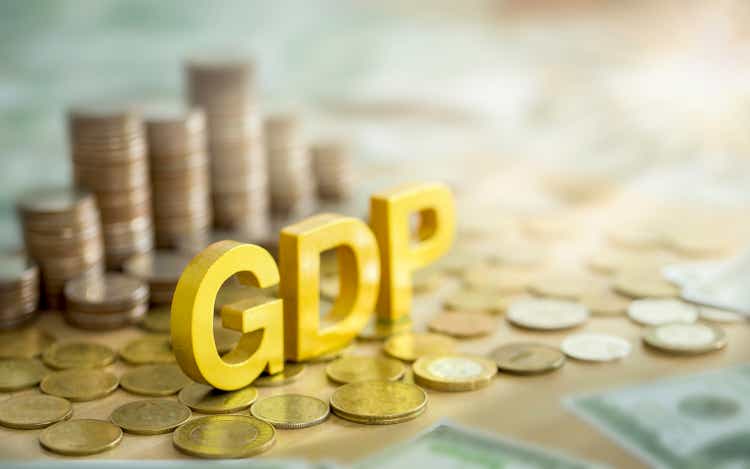Tanankorn Pilong/iStock via Getty Images
Listen below or on the go on Apple Podcasts and Spotify
Three strong economic reports give the Fed doves pause. (0:15) CarMax gets clobbered. (1:55) High-flying Oracle gets a rare bear. (2:18)
This is an abridged transcript of the podcast:
Our top story so far, this morning’s economic data just threw up a big speed bump on the easy money expressway. Initial jobless claims, durable goods orders and the final GDP revision all came in hawkish.
Wells Fargo economists said: “A data deluge this morning gives the U.S. economy a new lease on life.”
“Second quarter GDP, in hindsight, is stronger than it first appeared in light of robust consumer service spending and more robust business fixed investment,” they said. “August durable goods orders suggest the cap-ex momentum carried into Q3. Jobless claims fell for both first-time filers and those re-filing for existing benefits.”
Q2 GDP was perhaps the most eye-catching, even though that’s well in the rearview mirror. At the final print, the economy rose at +3.8% pace, up from the prior estimate of +3.3%.
Prices were also revised higher. The core PCE price index, which excludes food and energy, was revised up to 2.6% from 2.5% in the second estimate.
August durable goods orders rose 2.9%, compared with the -0.3% decrease expected and -2.7% in the prior month. Excluding transportation, new orders gained 0.4% last month, confounding expectations for a 0.1% decline.
And weekly jobless claims dropped unexpectedly to 218,000, well below the 238,0000 consensus and 232,000 the week before. Continuing claims dipped to 1.926 million from 1.928 million, lower than the 1.93 million consensus.
Following the data, the expected amount of Fed cuts this year fell to 38 bps from about 43 bps before the numbers hit. Treasury yields continued their recent march higher, with the 10-year yield (US10Y) touching 4.2% for the first time since the start of the month. And the dollar index (DXY) hit a three-week-high.
Among active stocks, CarMax (KMX) is plunging after falling short of consensus estimates with its second-quarter earnings report.
The company saw revenue decline 6% to $6.59 billion during what it said was a challenging quarter. That tally missed the consensus mark by $430 million. Total retail used vehicle unit sales decreased 5.4% to 199,729 compared to a year ago.
Oracle (ORCL) caught a Sell rating from Rothschild & Co Redburn.
Despite Oracle’s role in the massive Stargate Project with OpenAI, the Rothschild says the market is overestimating the value of Oracle’s contracted cloud revenue. It set a price target on the stock of $175, which is about 40% less than its current value.
And Rosenblatt analyst Chris Brendler started coverage on digital retail trading platform Webull (BULL) with a Buy rating, pointing to its international expansion and as well as a friendlier U.S. crypto regulatory environment.
“Crypto trading peaked at 20% of Webull’s revenuesin the last cycle, and while it likely won’t approach this level anytime soon, crypto is a key driver of our above-consensus estimates,” Brendler said.
In other news of note, Aldi is making another aggressive move in the U.S. grocery sector by rebranding its private label portfolio and launching its first-ever namesake brand. The rebrand will take place over the next few years. The Germany-founded company said the move is a direct response to customer feedback.
More than 90% of Aldi products are private label. Several brands will be replaced with the Aldi name, while brands like Clancy’s, Simply Nature and Specially Selected will remain on shelves with modernized branding. Other items like “Red Bag Chicken” will adopt shopper-given nicknames.
Aldi’s core strategy focuses on offering low prices through private labels, efficiency, and cost controls. The narrow focus has helped to boost Aldi’s global brand recognition in the era of inflation-weary consumers.
And in the Wall Street Research Corner, BofA strategist Savita Subramanian says the S&P 500 (SP500) is now trading as if it were the new risk-free rate.
The index trades rich on 19 out of 20 metrics, with four key measurements – market cap to GDP, price to book, price to operating cash flow and enterprise value to sales – hitting all-time highs.
“Buying stocks at these multiples feels bad, but there are good ways (sales/EPS/GDP booms) and bad ways (price declines) to resolve this seemingly untenable situation,” she said.
The index now features companies with “a lower debt to equity ratio than prior decades,” reducing one traditional source of market risk.
“Perhaps we should anchor to today’s multiples as the new normal rather than expecting mean reversion to a bygone era,” Subramanian said.
#Wall #Street #Lunch #Economic #Data #Throws #Cold #Water #Fed #Rate #Cut #Hopes
